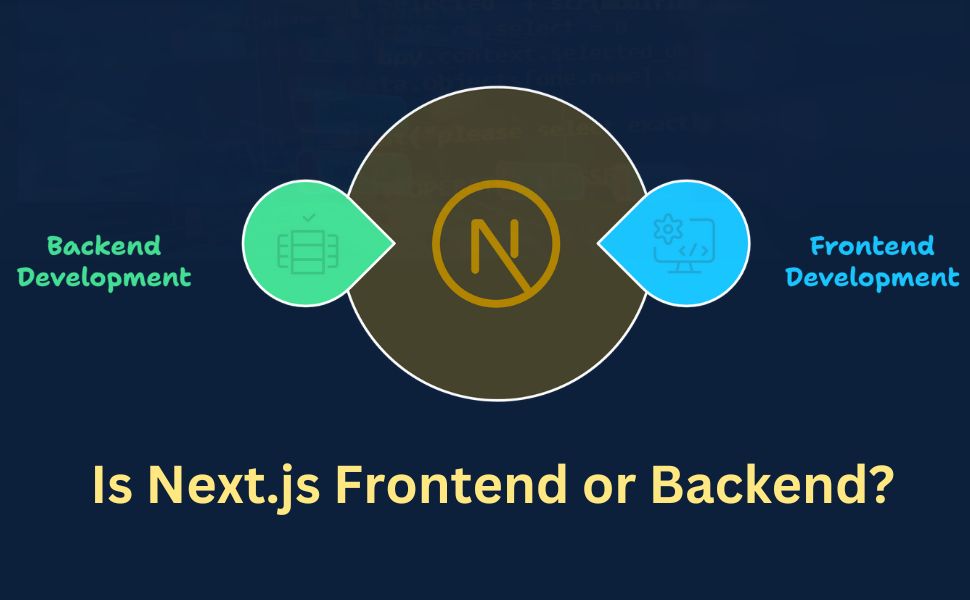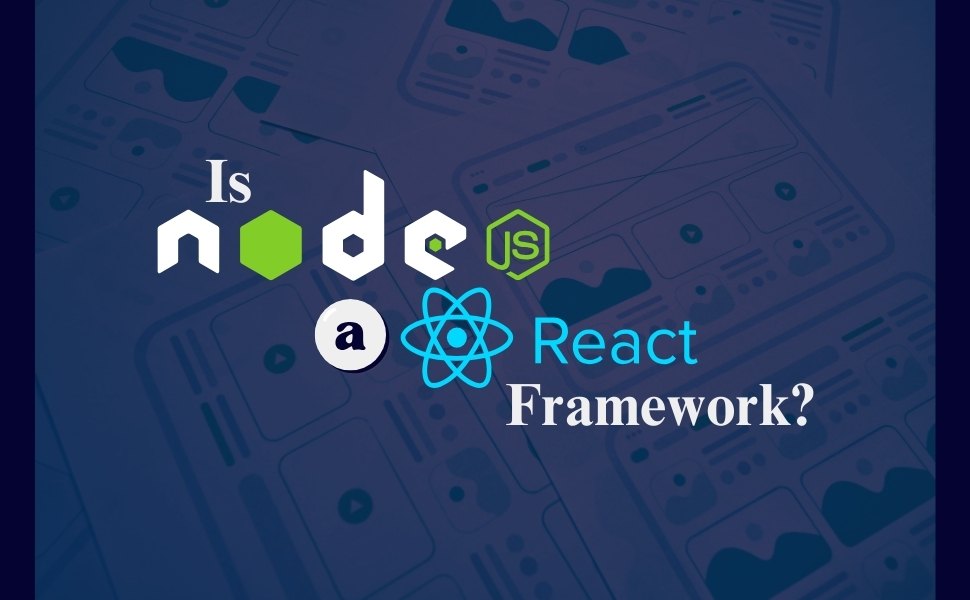Next.js is an amazing tool for web development. But many people ask, “Is it frontend or backend?” The answer is simple—it’s both! Next.js is a special framework that works on both the frontend and backend, making it very flexible.
You can use Next.js to build fast and interactive websites with its front-end features. At the same time, it can handle server-side tasks like creating APIs and rendering pages on the backend. This makes it a great choice for modern web development.
In this article, we’ll explain how Next.js works, its key features, and why developers love it. Let’s get started!
What is Next.js?
Next.js is a powerful framework built on top of React. It helps developers create modern, fast, and user-friendly web applications. While React is great for building components, Next.js adds extra features to make the process smoother and more efficient.
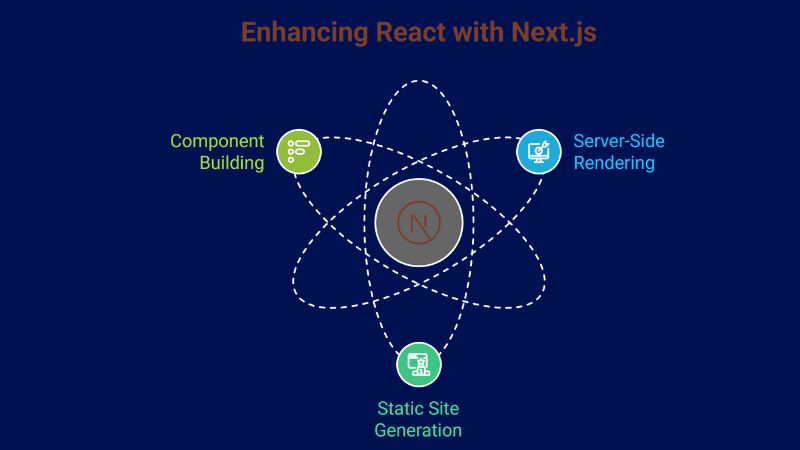
The main purpose of Next.js is to enhance React applications. It includes features like server-side rendering (SSR) and static site generation (SSG). These tools improve the speed, SEO performance, and overall user experience of websites.
Is Next.js Frontend or Backend?
Next.js is special because it works for both the front end and the back end. It builds on React, which is mainly used for the front end. The front end is the part of a website that users see and interact with. But Next.js also helps with the backend, which handles things like data and rendering pages before they reach the user.
On the front end, Next.js helps you create fast and interactive websites. It makes React apps better by splitting code and improving page loading speeds.
On the backend, Next.js lets you create API routes and use server-side rendering (SSR). This means the server prepares pages before sending them to the user. It helps with performance and SEO. So, Next.js is a great tool for working on both the frontend and backend of your app.
What’s the Difference Between Frontend and Backend Development?
Knowing the difference between frontend (client-side) and backend (server-side) development is key to understanding how Next.js works. Each plays a unique role in building websites and apps.
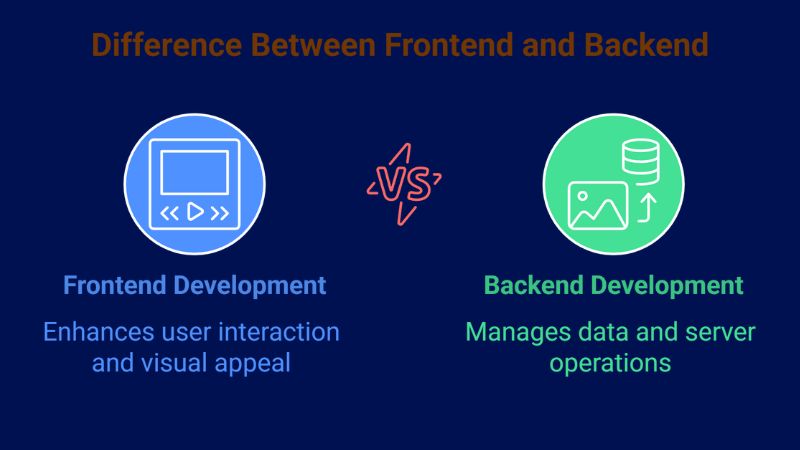
The front end (client-side) is the part of a website or app that users see and interact with directly. It includes things like the layout, buttons, images, and text. For example, when you visit a website, everything you click, scroll, or view is part of the front end. Developers use tools like HTML, CSS, and JavaScript to build the front end, ensuring it looks good and responds to user actions.
The backend (server-side) is like the engine that powers the app behind the scenes. It manages how the app works, processes data, and ensures that everything functions smoothly. For instance, when you log in, the backend verifies your details with the database and sends the correct response to the front end. Technologies like Node.js, Python, and PHP are commonly used to build the backend.
The front end and back end work closely together. The front end presents information to the user, while the back end processes requests and handles data. This collaboration makes websites and apps functional, user-friendly, and interactive.
Next.js plays a unique role by handling both frontend (client-side) and backend (server-side) tasks in one framework. This makes it a powerful tool for developers to create seamless applications.
Here’s a simple table to explain the difference between Frontend (Client-Side) and Backend (Server-Side):
| Aspect | Frontend(Client-Side) | Backend (Server-Side) |
|---|---|---|
| Definition | The part of a website or app users interact with directly. | The behind-the-scenes system that processes and manages data. |
| Focus | Looks, design, and user interaction. | Functionality, logic, and data handling. |
| Technologies Used | HTML, CSS, JavaScript, React, Vue.js. | Node.js, Python, PHP, Ruby, Java, .NET. |
| Examples | Buttons, forms, menus, animations. | Login authentication, data storage, API handling. |
| Runs On | User’s browser or device. | Server (cloud or local). |
| Purpose | Ensures a good user experience. | Ensures the app works as intended. |
| Key Role in Next.js | Renders pages and manages user interaction. | Handles server-side rendering (SSR) and API routes. |
This table highlights how frontend and backend differ but also work together to create functional and engaging web applications.
The Frontend Role of Next.js
Next.js is a powerful tool for building the frontend of websites. It works on top of React, which is a popular library for creating user interfaces (UI). But Next.js makes React even better by adding extra features that make websites faster and easier to build.
One of the great things about Next.js is how it handles routing. In a traditional React app, you have to manually set up routes for each page. But with Next.js, you don’t have to worry about that. Next.js automatically creates routes based on the files in your “pages” folder. So, if you add a new file, a new page is created with the right URL.
Another amazing feature is dynamic page rendering. This means Next.js can generate pages on demand, depending on the data it gets. For example, if a user visits a product page, Next.js can grab the product details and show them instantly. This is super useful for websites with content that changes frequently.
Next.js also helps you create fast and responsive websites. It uses techniques like Static Site Generation (SSG) to make pages load quickly. With SSG, pages are built ahead of time, so they’re ready to be displayed as soon as someone visits your website.
But if you need real-time updates, Next.js also supports Client-Side Rendering (CSR). With CSR, the content is rendered directly in the user’s browser. This makes websites feel interactive, like when you scroll through a feed or chat with someone online.
In short, Next.js makes it easy to build fast, responsive, and dynamic user interfaces. Whether you’re using static pages or real-time updates, Next.js has the tools to help you create a smooth and enjoyable user experience.
The Backend Role of Next.js
Next.js is not just for the front end—it also handles backend tasks, making it a full-stack framework. It provides an easy way to build both the front end and backend in one place.
One important feature of Next.js for the backend is API routes. These routes allow you to handle requests, just like you would in a traditional server. For example, you can create a route to fetch data from a database, process it, and send it back to the user. API routes are simple to set up and are perfect for small projects or when you don’t want to use a separate backend server.
Next.js also supports Server-Side Rendering (SSR). This means the pages are generated on the server, not in the browser. When a user requests a page, Next.js will fetch the necessary data, create the page on the server, and then send it to the browser. SSR helps with SEO (Search Engine Optimization) because search engines can read the page content easily. It also makes websites load faster, especially for dynamic content.
Another powerful backend feature of Next.js is the ability to handle authentication, data fetching, and databases. For example, you can use API routes to handle user logins or fetch data from an external database, like MongoDB or MySQL. All this backend logic can be integrated directly into your Next.js application, saving you the trouble of managing separate servers or services.
In summary, Next.js makes handling backend tasks like fetching data, managing user authentication, and interacting with databases easy. You can write all of this backend code in the same app, making it a smooth and simple process to manage both the frontend and back end in one place. Whether building a small app or a larger system, Next.js offers the tools you need for full-stack development.
Key Features of Next.js: Bridging Frontend and Backend
Next.js is a powerful framework that makes frontend and backend work together smoothly. It has many features that help developers build fast and efficient apps. Let’s look at some of the most important ones.
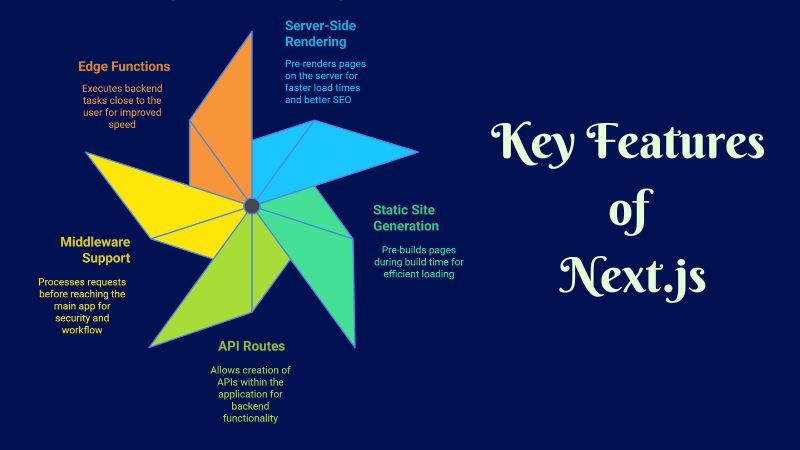
Server-Side Rendering (SSR)
Next.js can create pages on the server before sending them to the browser. When a user opens a page, Next.js gathers the data, builds the page, and sends it fully ready to the user. This process helps websites load faster and improves SEO by providing pre-rendered content.
Static Site Generation (SSG)
With SSG, Next.js pre-builds pages during the build process. This means that pages are ready to load instantly when users visit them. SSG is great for sites with content that doesn’t change often, like blogs or documentation. It combines speed and efficiency by reducing server work for each user request.
API Routes
Next.js allows you to create APIs directly within your application. You can define routes to handle backend logic, like fetching data, processing user input, or handling authentication. These API routes make it easy to add backend functionality without needing a separate server.
Middleware Support
Middleware in Next.js allows you to process requests before they reach the main app. For example, you can check if a user is logged in or add special instructions to a request. This helps make apps more secure and ensures smooth workflows.
Edge Functions
Edge functions are another cool feature of Next.js. They run backend tasks close to the user, usually through a content delivery network (CDN). This makes apps faster because the processing happens nearby, no matter where the user is in the world.
Next.js is a powerful tool that bridges the gap between frontend and backend development. Whether you need to handle dynamic content with SSR, pre-build static pages with SSG, or create custom backend APIs, Next.js has you covered. Its features are designed to make development faster, easier, and more efficient, making it a favorite choice for developers worldwide.
Why Next.js is a Full-Stack Framework
Next.js is called a full-stack framework because it handles both frontend and backend development in one place. Let’s break this idea into simple parts.
What is Full-Stack Development?
Full-stack development means building both the visible part of a website (frontend) and the behind-the-scenes logic (backend). The frontend handles what users see and interact with, like buttons and images. The backend manages things like databases, user authentication, and server requests.
How Next.js Combines Frontend and Backend
Next.js is special because it brings both frontend and backend together into a single framework. You don’t need to switch between different tools or platforms. With Next.js, you can create user interfaces using React for the front end and write backend logic like APIs in the same project.
One Codebase for Everything
In Next.js, everything stays in one place. You can manage routing, fetch data, and even build APIs without needing a separate backend setup. This makes development faster and simpler because you don’t have to move between different systems.
Next.js makes life easier for developers. You can build full-stack applications—complete with dynamic web pages, user-friendly interfaces, and backend logic—without juggling multiple tools. Whether you’re working alone or with a team, it makes the process faster and easier.
In short, Next.js is a full-stack framework because it seamlessly combines both the frontend and backend in one platform.
When to Use Next.js as a Backend Framework
Next.js isn’t just for building user interfaces. It also has strong backend capabilities, making it a great choice for handling server-side tasks. Let’s explore when Next.js works well as a backend framework.
Building APIs
Next.js makes it easy to create APIs using its API Routes feature. You can write server-side logic directly in your Next.js project without needing a separate backend framework. This is useful for handling data requests, connecting to databases, or creating endpoints for your application.
Handling Dynamic Data
If your app relies on real-time or frequently changing data, Next.js can manage it effectively. With server-side rendering (SSR), it can fetch and display updated data whenever a user visits a page. This ensures your app stays dynamic and responsive to user needs.
Managing Authentication
Authentication is a key part of many modern web apps. Next.js allows you to handle login systems and user management securely. You can integrate tools like JWT (JSON Web Tokens) or libraries like NextAuth.js to create a seamless and safe authentication process.
Next.js simplifies backend tasks by combining frontend and backend logic in one codebase. This reduces the need for multiple tools and keeps everything organized. It’s especially helpful for developers building full-stack applications or projects that require fast data handling.
Using Next.js as a backend framework can save time and effort while giving you powerful tools to build modern, dynamic web applications.
Advantages of Using Next.js for Full-Stack Development
Next.js is a powerful framework that helps developers build both frontend and backend in one place. This makes development faster and more efficient. Here are some key advantages of using Next.js for full-stack development:
Faster Development
Next.js allows developers to write both frontend and backend code using JavaScript. This removes the need to switch between different languages. It makes the development process smoother and more efficient.
Scalability
Next.js supports Server-Side Rendering (SSR), Static Site Generation (SSG), and dynamic page loading. These features make it easy to scale applications as they grow. Whether your site has a few pages or thousands, Next.js can handle it well.
Improved SEO
Search engines prefer websites that load quickly and provide fresh content. With SSR, Next.js ensures that pages load fast and show up better in search engine rankings. This helps improve website visibility.
Better Performance
Next.js is built for speed. It optimizes images, loads pages quickly, and reduces unnecessary requests. As a result, users experience smooth and fast-loading applications.
Seamless Deployment
Since Next.js combines both frontend and backend, deployment is much easier. You don’t need to set up separate servers. Hosting providers like Vercel and Netlify offer direct support for Next.js, making deployment simple.
Next.js brings everything into one framework. It saves time, improves performance, and makes web development easier. Whether you’re a beginner or an expert, Next.js is a great choice for building scalable, SEO-friendly, and high-performance web applications.
Build Your Custom Website or App with BoomDevs
Do you need a custom website or mobile app? BoomDevs is here to help! We create websites, apps, and digital solutions for all kinds of businesses. Our expert team uses the Next.js framework and other modern technologies to build fast, secure, and high-performance applications. Whether you need a simple website or a complex web app, we can make it happen.
At BoomDevs, we focus on quality, speed, and customer satisfaction. We use the Next.js framework to make websites and apps that load quickly and work smoothly. Our team ensures your project is scalable, secure, and easy to use. No matter your business size, we provide reliable service and on-time delivery. Let’s create something great together! Contact us today.
Frequently Asked Questions (FAQs)
Q1. Is Next.js a frontend or backend framework?
Next.js is a full-stack framework. It is mainly used for frontend development with React but also has backend features like API routes, server-side rendering (SSR), and database connections.
Q2. Can I use Next.js only for frontend development?
Yes! You can use Next.js as a frontend-only framework to build fast, SEO-friendly websites. It works well for static sites, blogs, and marketing pages.
Q3. Does Next.js replace the need for a backend?
Not always. While Next.js has backend features, complex applications may still need a separate backend for databases, authentication, and business logic.
Q4. How does Next.js handle backend tasks?
Next.js provides API routes, which let you create backend endpoints inside your project. You can also connect to databases, process authentication, and manage user sessions.
Q5. Is Next.js better than traditional frontend frameworks?
Next.js offers advantages like Server-Side Rendering (SSR), Static Site Generation (SSG), and improved SEO. These features make it better for performance and search engine ranking compared to regular frontend frameworks.
Q6. When should I use Next.js for backend development?
You can use Next.js for backend tasks when you need API development, handling dynamic content, or user authentication within the same project.
Q7. Can I connect Next.js with a database?
Yes! Next.js supports database integration with tools like MongoDB, PostgreSQL, and Firebase for storing and managing data.
Q8. Is Next.js good for building full-stack applications?
Absolutely! Next.js is designed for full-stack development, allowing developers to manage both frontend and backend in a single project.
Final Words
Next.js is a powerful framework that works for both frontend and backend development. It helps developers build fast, SEO-friendly websites while also handling server-side tasks like data fetching and authentication. This makes it a great choice for full-stack development.
Whether you need a responsive UI, dynamic pages, or backend functionality, the Next.js framework has you covered. It gives you the flexibility to build modern, scalable, and high-performance applications. If you’re looking for a framework that simplifies web development, Next.js is the perfect choice.



